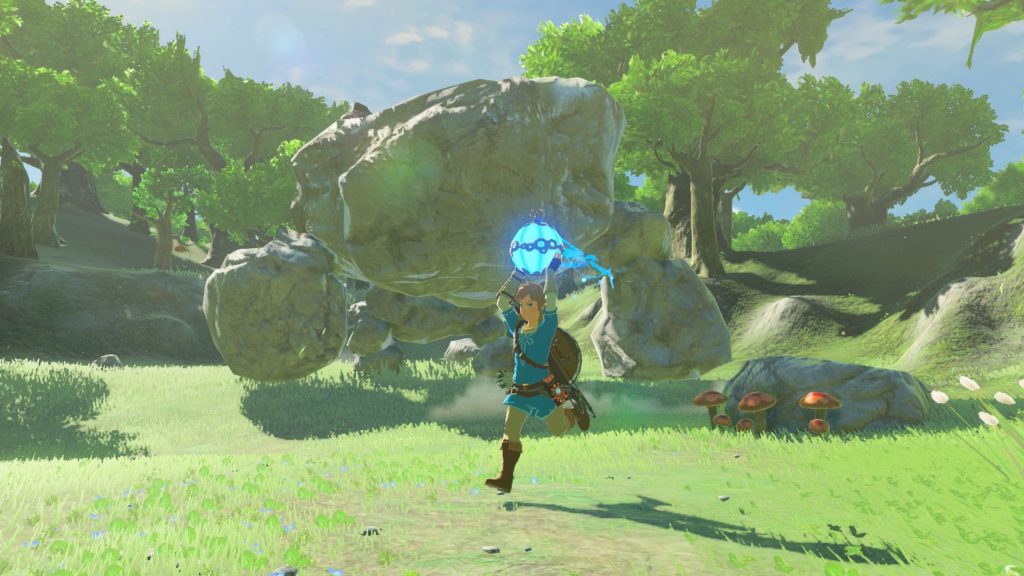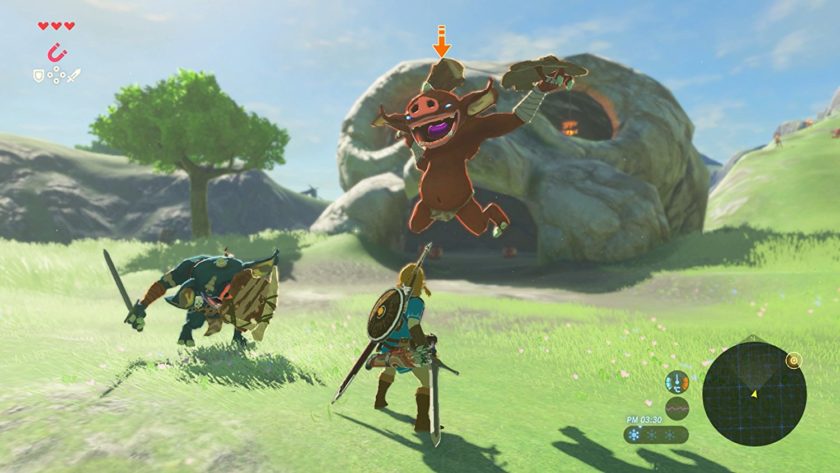The Legend of Zelda: Breath of the Wild rewrote the book on open world game design when it launched alongside the original Nintendo Switch eight years ago. That’s a long time ago – tech in games moves quickly, and the Switch hardware was outdated (at best) at launch to begin with.
This means that a new visual upgrade for one of the most beloved and celebrated games of all time was a no-brainer – particularly with the Switch 2 providing Nintendo much more powerful hardware to play with. And so, we have The Legend of Zelda: Breath of the Wild – Nintendo Switch 2 Edition, which, alongside the game’s sequel Tears of the Kingdom, updates the modern classic for more capable hardware.
The upgrades themselves are hardly anything to sneeze at. Breath of the Wild on Nintendo Switch runs at a persistent, steady 60 frames per second. The frame rate drops the game infamously suffered from in several areas – such as the starting Great Plateau region, or the Lost Woods/Korok Forest, hold their frame rate (which is doubled to begin with) significantly better this time around.
In my experience, trying to set off as many CPU-heavy processes (such as physics and chemistry interactions) while also trying to fight as many enemies on screen at a time as possible, the frame rate held up remarkably well – at one point there was a brief slowdown when I hit about a dozen hitboxes at the same time, but other than that, the game itself runs at a blistering 60FPS, which alone can make all the difference for a lot of people.
That said, there is more on offer with this updated version too – for starters, the resolution is a lot higher now, in portable and docked modes alike. Playing Breath of the Wild on a Switch 2 in handheld mode, the game runs at a 900p resolution, whereas in portable mode, it renders at 1440p. Both of these are higher than the Switch version’s 720p for handheld mode and 900p for docked mode, and significantly higher than the Wii U version’s 720p. Additionally, the game supports HDR now, and also comes with a bunch of new features and content that can be accessed through a companion app, and, of course, supports significantly quicker loading courtesy of the Switch 2’s SSD caliber data transfer speeds.
"The other improvements and additions, however, mostly feel nice, but inessential."
Let’s stick with the visual upgrades for now, because these are the most immediate and the most apparent. Other than the aforementioned 60fps, the higher resolution and HDR both do wonders. Breath of the Wild was always a good looking game, but ultimately it was constrained by the hardware it was on. Seeing it run in 1440p at 60FPS with HDR support, the game’s gorgeous aesthetic comes to life and sings, with Nintendo’s stylized and palette focused visual style working extremely well with an HDR-enabled high resolution image. These improvements work to increase the game’s draw distance (which was already impressive in the Switch build, but is even better here), and other than enhancing the game’s sense of immersion and presentation, all come together to make an already great game feel even more pleasant to play.
Non-visual improvements help with that too – I specified much faster loading earlier, and yes, the fact that loading of any kind – a cold boot, fast traveling, or the transition screens when entering or exiting the game’s mini-dungeon area style Shrines – basically last a second or two at most. The loading times weren’t too bad to begin with, but they were longer than this, by a fair bit. For a game you are going to spend dozens if not hundreds of hours on playing, shaving off a few seconds on each load can make a big difference in the long run.
There are other improvements on offer as well – for instance, you now (finally) get two save slots to have two separate ongoing campaigns in progress, rather than having to overwrite the older one. This is in addition to the extra slot you get from Master Mode (which also gets its own extra slot). Suffice it to say, the days of having to delete your older file to start a new one are at an end.
The other improvements and additions, however, mostly feel nice, but inessential. For example, let’s talk about Zelda Notes. Taking a leaf out of the playbook of every major console release circa 2013 or so, Zelda Notes syncs up with your save as you play and provides a bunch of neat bonuses and content you can get no other way. These include a GPS-style voice guided navigation, voice memories that can be unlocked and played in certain locations, play stats, support for editing and enhancing the photos you took in-game, and a smattering of other minor features, including tips and help, as well as achievements.

"The Switch 2 upgrade is also notable for the things it doesn’t have. Most significantly, it does not include the paid DLC and expansion for Breath of the Wild, which must (still) be bought separately."
None of these particularly add to, or detract from, the game. They are nice to have, but you can play Breath of the Wild without ever being aware of them (which, I suspect, will be the case for most people), and still miss nothing whatsoever. Some of the features are ones that I could see being consequential – navigation assistance is good for a game that gives you giant open world with few objective markers, but having to have your phone on hand for it is annoying.
The new context given the Voice Memories you find can be a great insight into this world – but again, you need your phone on hand for it. I do like the global and local stats tracking that Zelda Notes provides a lot, and to me, that is its killer feature. But I love tracking stats, so that makes sense – for the average player, I don’t know how much value that would hold.
The Switch 2 upgrade is also notable for the things it doesn’t have. Most significantly, it does not include the paid DLC and expansion for Breath of the Wild, which must (still) be bought separately. This is a baffling omission, particularly given that the Switch 2 Edition of the upgrade is pricey to begin with. The DLC wasn’t essential, so missing out on it won’t diminish the experience of playing the base game, but it absolutely calls into question the value of this package when, for an eight year old game, it doesn’t include all the content. There are also some minor QoL upgrades Tears of the Kingdom added which would have been nice to have back ported into Breath of the Wild, but their absence, while a bummer, doesn’t particularly rankle as much as the DLC’s absence does.
So in terms of the actual upgrades, it’s a mixed bag. There’s some great stuff – the loading and visual improvements – as well as some misses (the DLC), while there’s some stuff that is nice to have but completely inessential. All of which adds up to this being a fairly average upgrade for an extraordinary game.

"If this is your first time playing Breath of the Wild, I am frankly jealous of you – it’s a truly unforgettable and indelible experience"
And the game is extraordinary, even today, in 2025, more than eight years after it first came out and rewrote the playbook. Breath of the Wild is an incredibly hyped and beloved game, and it has frequently been heralded as the greatest game ever made. That praise is well earned – the game’s approach to open world design, its incredible player-driven game loop, and its emphasis on mechanics that facilitate dynamic and emergent gameplay, have led to a game that even after nearly a decade and hundreds upon hundreds of hours poured into it by more than 30 million players worldwide, continues to surprise and delight.
If this is your first time playing Breath of the Wild, I am frankly jealous of you – it’s a truly unforgettable and indelible experience, and even now, there are very few open world games that even begin to approach what it goes for, let alone actually pulling it off well. Playing it now, without the technical or graphical hiccups that marred the original, and getting it in this polished form, is probably going to be an amazing experience. For all the game’s misses, then you will probably rack up a list of those, from dungeons to bosses to permanent upgrades, all of which are heavily sidelined in this title – what it does well, it does so extraordinarily well, that it rises beyond those stumbles and becomes far more than the sum of its parts.
Breath of the Wild is one of the best games ever made. It having a more modern version readily available is a great thing, and if there were players who were interested but turned off by its poor resolution or performance, it’s great that those will no longer be problems here. That said, other than the graphic and tech, the upgrades seem like a bit of a mixed bag – I do think they could have added some better content to the game than what is in Zelda Notes, or at the very least, they could have added Zelda Notes’ content directly to the game itself. I also think not including the DLC content in this package is a poor decision.

"Breath of the Wild is one of the best games ever made. It having a more modern version readily available is a great thing, and if there were players who were interested but turned off by its poor resolution or performance, it’s great that those will no longer be problems here."
Overall, then, this is a mixed update for an all-time great game. If you have never played Breath of the Wild previously, and this will be the first time you do, then almost nothing in this review should matter or register for you. Ignore the nitpicking of a seasoned player who spent more than 400 hours on this game, and lose yourself in one of the finest adventures the medium has ever turned out. If you are a returning fan, then it is great to finally have this upgraded version on hand – but given the fact that this is a paid upgrade, it is a bit disappointing that the updates included aren’t more convincing.
This game was reviewed on the Nintendo Switch 2.
The Legend of Zelda: Breath of the Wild Switch 2 Review – A Glorious Upgrade Missing a Few Pieces
Source: Buzz Trends Updates
0 comments:
Post a Comment